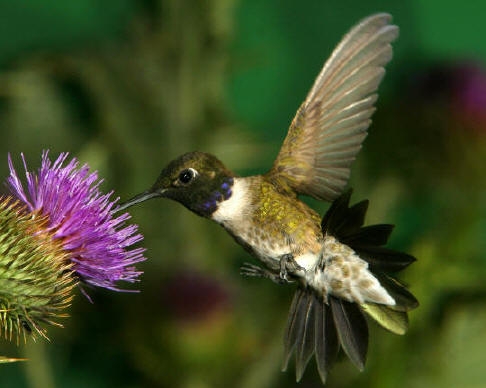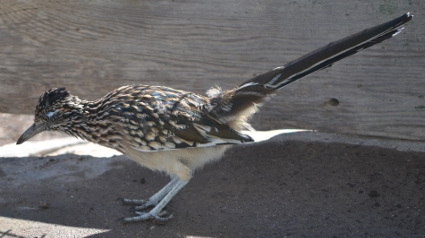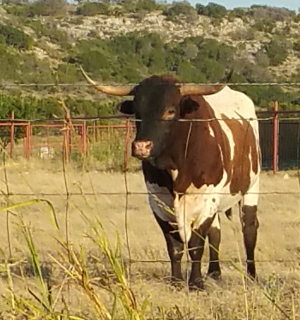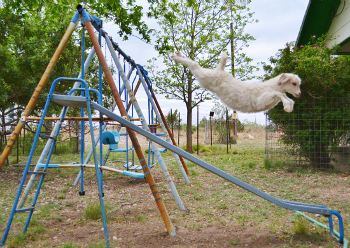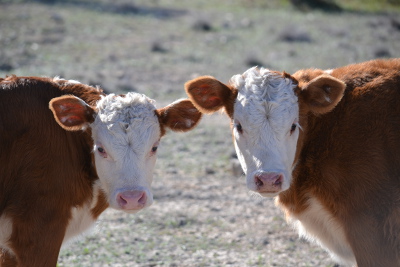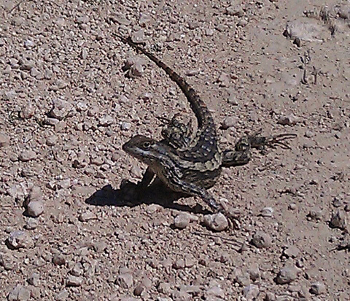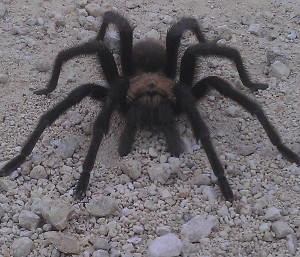North American Monarch Butterfly
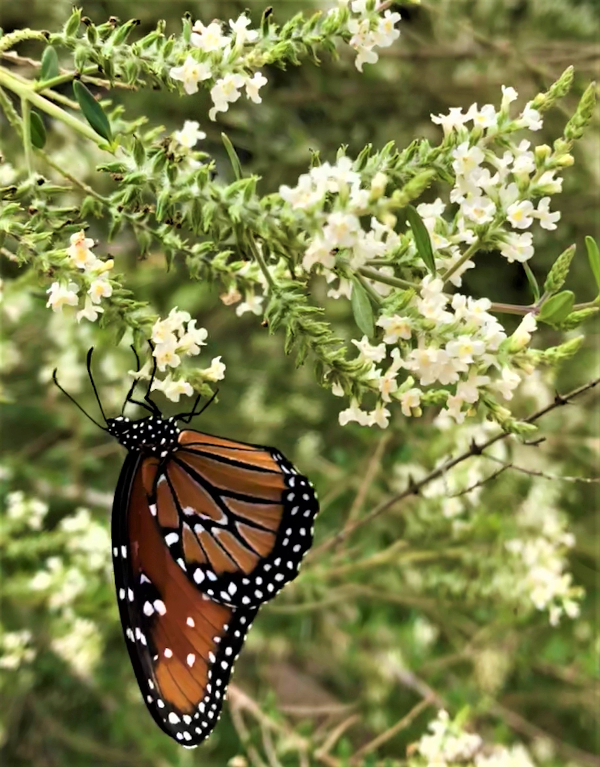 North American Monarch Butterflies pass through Ozona and the Crockett County area twice a year. In the spring, they leave their wintering grounds in Central and Southern Mexico and head northward on a journey that may cover up to 2,500 miles. They usually pass through our area in March or early April. In the fall, around September or early October, they return southward from summering as far north as Canada on their way back to Mexico. Other types of Monarchs may be found throughout the world.
North American Monarch Butterflies pass through Ozona and the Crockett County area twice a year. In the spring, they leave their wintering grounds in Central and Southern Mexico and head northward on a journey that may cover up to 2,500 miles. They usually pass through our area in March or early April. In the fall, around September or early October, they return southward from summering as far north as Canada on their way back to Mexico. Other types of Monarchs may be found throughout the world.
The North American Monarch population has recently been suffering a decline. In fact, in 2022, the International Union for the Conservation of Nature listed them as only two steps away from extinction. The U.S. Fish and Wildlife Service also considered adding the Monarch to its federal endangered species list in 2020 and will revisit this topic in 2024.
There are several possible causes for this decline, but it is generally believed that the use of pesticides has reduced the only plant they use to lay their eggs, the common milkweed. They lay their eggs for the next year’s generation on their northward migration. Once the eggs hatch, the milkweed plant is also the only plant that the larvae and caterpillars eat.
One way we may be able to help is to plant more milkweed. The specific subspecies recommended for our area are the Green Milkweed (A. viridus), the Antelope Milkweed (A. aspirula) and the Zizotes Milkweed (A. oenotheroides).
Another possible cause of their decline may be related to climate change, although this is debated among various groups.
The Monarchs have a very complex life cycle. Their migration is completed by as many as four generations throughout the year, with each generation making only part of the journey. This introduces another level of difficulty in determining just what is causing the numbers to decline. Depending on the way they are counted and in what area the count is made, the number counted can vary greatly.
If you ever find yourself in Ozona during one of the spring and fall migrations, which last only a few days in the area, the Crockett County Interpretive Trail provides an excellent place to view these magnificent creatures as they pass through.
Find even more information about how you can help the Monarchs at www.monarchwatch.org.
Black-chinned Hummingbird
One of the many species of birds that can be observed in the Ozona area is the Black-chinned hummingbird. These birds may be found in many areas across the United States and Mexico. Very adaptable, their natural habitats range from mountain forests, deserts and coastal plains. Many migrate to the Gulf Coast or Mexico to spend their winter months in a warm climate. Less than four inches long, the males of this species are identified by the black chin bordered by the thin strip of iridescent purple. The purple strip is only visible when the light strikes at just the right angle. Females do not have the purple strip. Their bodies are primarily green on the top with lighter shades underneath. When the babies hatch, they are almost featherless, but within three weeks, they have grown a complete set. Molting usually begins in November, but will not be totally complete until April or May.
The male hummingbirds can be very territorial, especially around feeders, and will become increasingly so as breeding season approaches. However, when food is plentiful, the hummingbirds will rarely show their aggressive behavior. When trying to defend an area or attract a female, the males will dive in a U-shaped swoop as much as 50 to 100 feet, passing close to the predator or female at the bottom of the dive.
The females construct well-camouflaged nests in trees or shrubs from plant fibers, spider webs, and lichens. Some research suggests that they purposefully choose to nest near larger, predatory birds as a way of defense. This seems counter-productive, but the larger birds are rarely interested in the hummingbirds and deter other pests from coming near the hummingbird eggs or newly-hatched chicks. The females usually lay from 1 to 3 tiny eggs which will hatch after a period of about 12 to 16 days.
The hummingbirds have an extremely fast metabolism which requires a large amount of sugary nectar. They feed on over 90 species of flowers, and have incorporated hummingbird feeders into their normal diet. They also eat small insects and spiders, especially when hatching young. These birds can fly forward, backward, sideways and even on their backs. They can hover, take off vertically and are able to pivot around a stationary axis. Their wings beat at 50 beats per second and this rapid wing movement produces the humming sound for which they are named. Smaller birds' wings can move even faster than large. The massive muscles necessary to move in this way actually make up a third of their body weight.
Many types of birds and butterflies visit our Crockett County Interpretive Trail!
For more information about the area, visit our Local and Area Attractions pages!
Ozona-Barnhart Trap Company
 In 1883, the first water well was drilled in Crockett County. Prior to this, limited water supplies meant limited cattle industry. But soon after this first water well was completed, wells and windmills spread throughout the county. With reliable water resources, ranchers found that cattle-raising was a viable industry. Progress also brought difficulties. Ranchers were soon fencing their properties to protect their grass and water, and by the 1920’s the fencing had blocked all the routes used to drive cattle from Crockett County to the railroad loading pens in Barnhart, about 30 miles north of Ozona.
In 1883, the first water well was drilled in Crockett County. Prior to this, limited water supplies meant limited cattle industry. But soon after this first water well was completed, wells and windmills spread throughout the county. With reliable water resources, ranchers found that cattle-raising was a viable industry. Progress also brought difficulties. Ranchers were soon fencing their properties to protect their grass and water, and by the 1920’s the fencing had blocked all the routes used to drive cattle from Crockett County to the railroad loading pens in Barnhart, about 30 miles north of Ozona.
But the early leaders of the county had a history of working together and quickly organized the Ozona-Barnhart Trap Company in 1924. By buying or leasing land for trails, traps (small pastures), pens and water wells, the group established a corridor for the livestock to be driven to the railroad without crossing fences or destroying grass supplies. With branch lines throughout the county, the main branch of the trail was about 34 miles long, from south of Ozona to the loading pens in Barnhart.
Although the demand for the trail was diminished by the advent of cattle truck transportation, the trail continued to be used until the 1950’s. The marker shown in the photograph is located about 11 miles northwest of Ozona on Texas Highway 163, near the site of the McNutt traps, a main hub of the trail. To see this historical area as well as many other historical places in Crockett County, visit Ozona and Hang Your Hat in History!
To view other interesting history facts, visit our Crockett County Historical Markers
For more information about the area, visit our Local and Area Attractions pages!
Fox Squirrel
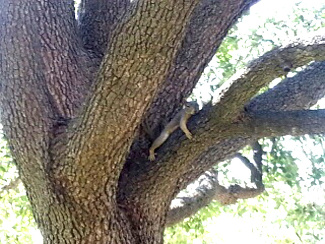 Texas is home to many species of squirrels, including the fox squirrel found throughout Crockett County. Actually a member of the rodent family, these very adaptable creatures flourish where large mature trees provide lots of shade and prevent under-brush from growing. Squirrels can be seen gathering food and playing in the branches of many pecan trees in the parks and tree-lined streets of Ozona. Nuts form a large part of the squirrels’ diet, but they will also eat insects, buds, green shoots, fruits and other seeds.
Texas is home to many species of squirrels, including the fox squirrel found throughout Crockett County. Actually a member of the rodent family, these very adaptable creatures flourish where large mature trees provide lots of shade and prevent under-brush from growing. Squirrels can be seen gathering food and playing in the branches of many pecan trees in the parks and tree-lined streets of Ozona. Nuts form a large part of the squirrels’ diet, but they will also eat insects, buds, green shoots, fruits and other seeds.
An adult squirrel usually weighs less than two pounds and will be about twenty inches long. Older females usually have two sets of young each year, around March-April and June-July. Litters of two to four babies are born blind, naked and helpless. They must be cared for in the nest until they about seven or eight weeks old. By the time they are about three months old, they can fend for themselves, but will not bear young of their own until they are about ten or eleven months old.
When feeling threatened, the fox squirrel will hide rather than run. It will lie motionless or move to the opposite side of a limb or tree trunk, peeking around to watch the movement of the predator. As the threat moves, the squirrel will shift so the tree will remain between it and the predator at all times.
Squirrels have been a popular game animal and were such a large part of the early rural menu they were given the nickname “limb chickens”. Though not eaten as much today, squirrel stew is still a favorite of many Texans, although most think that the gray squirrel found in east Texas tastes better and is more tender than the fox squirrel.
For more information about the area, visit our Local and Area Attractions pages!!
Gaspar Castaño de Sosa was born in Portugal in the mid 1500’s. By the late 1580’s Don Gaspar had moved to New Spain and taken leadership of the Villa de Almadén, now called Monclova, Mexico, located approximately 300 miles south of Ozona, TX. By July 1590, Castaño grew discouraged with the unproductive mines of Almadén and set out with 170 persons, carts, tools, and supplies, headed toward New Mexico. His journey brought him north to the Rio Grande near Del Rio, TX, then continued following the Pecos River, passing through western Crockett County and on to the area north of present day Albuquerque. Unfortunately, Castaño had not received permission to start a new colony and was charged with leading an unauthorized party into New Mexico. Arrested and returned to New Spain, he was convicted and exiled to the Philippines. Though his sentence was eventually overturned, it was too late for Don Gaspar. He was killed aboard a ship in the South China Sea during a slave insurrection.
To view other interesting history facts, visit our Crockett County Historical Markers
For more information about the area, visit our Local and Area Attractions pages!
Black-tailed Jackrabbit
The Black-tailed Jackrabbit is not really a rabbit at all. It is a hare. This species is one of the more widely distributed species of jackrabbits in North America, and can be found from central Washington state to Missouri and as far south as Baja, California and Zacatecus, Mexico. Its range is gradually spreading eastward in the Great Plains and they have been introduced in Florida, Maryland, New Jersey and Virginia. Although they can live up to 5 or 6 six years, they usually are killed by predators much younger than that.
Growing to a length of about 2 feet, the average Black-Tailed Jackrabbit weighs between 3 to 6 pounds. They have extremely large ears, which help them to regulate their body temperature in the hot arid environments. Their fur is a peppery brown color with a dark stripe down the back.
Lean and lanky, Black-tailed Jackrabbits are very fast and have been known to run at speeds up to 30-40 miles per hour. They can jump a distance of over 10 feet in a single bound. An important food source of eagles, hawks, owls and other raptors as well as carnivorous mammals like coyotes, foxes and wild cats, the jackrabbit is usually only active at dusk or night, preferring to spend the day in a hollowed out spot under a shade tree. When trying to evade one of its predators, the jackrabbit will run in a zig-zag pattern. It also flashes the white underside of its tail to confuse its pursuer and warn other jackrabbits of the danger.
The young are born fully furred with their eyes open. Mobile in just minutes, the babies, called leverets, are not guarded by the mother. She will separate the litter, placing each one in a separate spot. She does not stay with the leverets, and only comes near for feeding. The leverets nurse for 3 or 4 days and are completely independent within a month. Adult rabbits mate year round, and the female may have up to 4 litters a year, with 1 to 6 leverets in each litter. This rapid ability to reproduce often leads to overpopulations and can lead to die offs, with numbers of jackrabbits in an area fluctuating wildly. This species does not migrate or hibernate, and each rabbit’s habitat is only about 1 square mile or less.
Black-tailed Jackrabbits are strict vegetarians, feeding on grasses, shrubs, and wildflowers. Usually found in prairies and pastures, they use the openness to help them spot their predators before the predators spot them. Jackrabbits rarely drink water, getting most of their fluid from the plants they eat. Regarded by many as pests, fifteen jackrabbits can eat as much as a full-grown cow. They are also a host to many parasites such as fleas, ticks, lice and mites, so hunters sometimes avoid collecting them.
For more information about the area, visit our Local and Area Attractions pages!
The Greater Roadrunner is frequently seen in Crockett County and is found in all Texas counties. Its habitat spreads throughout the southwestern United States and Northern Mexico. These extremely adaptable birds have recently been reported as far north as Kansas and eastward into Missouri. A member of the Cuculidae or cuckoo family, their scientific name, Geococcyx californianus, means “Californian earth cuckoo”.
The Greater Roadrunner has several traits that differentiate them from many other birds. Adults are usually between 20 to 24 inches long with a wingspan between 17 to 24 inches. In this species, male and female birds look alike: bushy crest, long thick bill, a long dark tail, dark head and back with a mostly white belly. Brown in color, they have pale gold spots or streaks. Unlike most birds, the Greater Roadrunner has four toes on each foot, allowing it to climb and grasp objects. Small patches of blue and orange skin are located behind the eyes. Capable of limited flight, the roadrunner spends most of its time walking or running on the ground. The world’s fastest flying bird, the roadrunner has been known run at speeds of up to 26 miles per hour, but usually its speed is around 15 mph.
Roadrunners will eat almost anything: insects, spiders, small mammals, fruits, seeds and prickly pear, but their particular favorites include lizards and rattlesnakes! The method of killing prey is also unusual. Using its speed and agility, roadrunners chase down and grab prey with its beak and then slam it against the ground until dead. When killing rattlesnakes the birds will run quickly around the snake, leap into the air and then stab it with its pointed beak. After repeated blows stun the snake, the roadrunner pounds it repeatedly on the ground or rocks until its bones are crushed. If the snake is too long to eat, the birds can be seen running around with partially swallowed snakes dangling from its mouth.
The breeding season of the Greater Roadrunner lasts from March to October, and during this time a pair of roadrunners may raise up to three broods. Both the parents work together to provide food for the newly hatched babies. One parent will stand guard by the nest, while the other parent hunts for food. When the hunting parent returns to the nest with prey, the guarding parent will switch roles and leave to hunt for more. This continues until the hatchlings are old enough to leave the nest, usually at around 18 days old. If the food demands are too great for one hunting parent, then both will hunt once the babies are larger. After leaving the nest, the young remain close to the parents for a while longer, learning to hunt for themselves. Typically long-lived, the Greater Roadrunner lives to be about 7 to 9 years old. This and their amazing adaptability allow the roadrunner to thrive even with the encroachment of population into their traditional habitats.
Many interesting beliefs, superstitions and folklore have been inspired by the Greater Roadrunner. According to J. Frank Dobie, author and fan of roadrunners, the Pueblo Indians would draw the bird’s track on the ground near the tent of a dead loved one in order to mislead evil spirits away from the departing soul. In the Sierra Madre, the Tarahumare Indians believed their running skill came from eating roadrunner meat. When early travelers were lost, they would follow the roadrunner’s tracks because they believed that no matter which way they led, they would eventually reach a road or trail. This belief was based in fact because roadrunners hunt for insects in the vegetation along roads and animal paths. In Mexico, some said the roadrunners brought babies much like the stork in European folktales. Today, many are entertained by the popular cartoon with Wile E. Coyote trying to catch Road Runner. Poor Wile E. never catches him, though he tries everything ACME has to offer. But in real life, coyotes are faster than roadrunners, so the birds often make a tasty treat.
Many types of birds and butterflies visit our Crockett County Interpretive Trail!
For more information about the area, visit our Local and Area Attractions pages!
TEXAS LONGHORN CATTLE
The Texas Longhorn cattle breed evolved from the mixing of the first Spanish cattle to arrive in the New World with cattle from the east, which included British stock. The direct ancestors of the longhorns first arrived in 1493, brought over by Christopher Columbus to the Caribbean island of Hispaniola. The cattle moved with the Spanish settlers as they expanded their reach throughout the continent, crossing first to the eastern coast of Mexico during the 16th and 17th centuries. It is believed that the first known cattle in Texas arrived with the Franciscan missionaries as they moved north to establish a string of missions through the San Antonio valley and toward Goliad. The cattle also were being brought into California under similar circumstances, and soon spread into Arizona and New Mexico.
Over the next 350 years, the feral cattle that had escaped or been set loose throughout the continent developed through natural selection into a hardy, disease resistant, prolific breed. They could survive in harsh environments, could travel long distances for water, breeding or forage, and could raise a healthy calf every season without the intervention of man. Their hard hooves and characteristic long horns also enabled them to protect themselves from predators.
Commercially, the longhorn became valued because of its hide and tallow. Since tallow was the main ingredient in candles, longhorns were used to supply New England and Europe with a steady supply. The beef was a secondary product because at that time there was no refrigeration to preserve the meat.
By the end of the Civil War, it is estimated that Texas had about 6 to 8 million head of longhorns. With the economy still reeling from the effects of the war, some enterprising ranchers began driving herds northward to markets through what became known as the Chisholm and Goodnight-Loving Trails as well as other routes. Amazingly, the longhorn would actually gain weight along the way.
Unfortunately, one of the longhorn strengths became its downfall. Having evolved a natural and healthy resistance to sickness, the longhorns would carry disease-ridden ticks north and eastward, infecting less hardy breeds with Cattle Tick Fever as they went. The fever was devastating to other herds and eventually the longhorn was banned from Missouri and eastern Kansas. Nevertheless, it is estimated that 10 million head of longhorns were driven north out of Texas by the late 1880s. Although very successful in Mexico and South Texas under the system of allowing the cattle to pretty much take care of themselves, the breed was not well suited for the ranges in the northern US and Canada. This combined with the problems of tick fever and the division of ranches by barbed-wire fences spelled doom for the longhorn. Viewed as scrub cattle that should be eliminated from herds, the numbers fell sharply and by 1910, the breed was almost extinct.
In 1927, thanks to the efforts of a few conservationists and historians, Congress arranged to save the dying breed. A few remaining pure-bred longhorns were gathered to place on a wildlife refuge in the Wichita Mountains near Cache, OK. Starting with 20 cows, 3 bulls and 4 calves, the herd gradually increased to what was called the Wildlife Refuge or WR herd. A few other cattlemen kept isolated herds on their ranches as a nod to history. In the end, only seven “families” of longhorn survived.
The first registry for longhorn was set up in 1964, to keep breeding records and confirm the purity of bloodlines. The Texas Longhorn Breeders Association of America was organized largely through the efforts of Charles Schreiner, III, of the YO Ranch.
Since 1948, an official Texas Longhorn herd has been maintained and kept at Fort Griffin State Historical Site. Other smaller herds were established at Possum Kingdom State Recreation Area, Palo Duro Canyon State Scenic Park, Abilene State Park, Dinosaur Valley State Park and Copper Breaks State Park. Author J.Frank Dobie was one of those involved with establishing many of these herds with financial support from oilman Sid W. Richardson.
Today the Texas Longhorn is gaining in popularity again. Its lean beef has become sought after by increasingly health-conscious Americans. It is also highly prized as a “genetic gold mine” for traits of hardiness, disease resistance, longevity and high fertility for other breeds. In the late 1990s there were more than 250,000 longhorns and they are now located in all 50 states, Canada and Mexico. The numbers are expected to continue to grow well into the future.
Crockett County, as part of the Goodnight-Loving Trail, was on the route used by thousands of longhorns as they traveled the long and dangerous route across West Texas to New Mexico and Colorado. Imagine yourself as a tough cowboy, driving the huge herds toward the famous Horsehead Crossing across the Pecos River. Even today, travelers in Crockett County are sometimes treated to the sight of longhorns grazing in the pastures, a reminder of what the country was like centuries before.
For more information about the area, visit our Local and Area Attractions pages!
BRAHMAN CATTLE
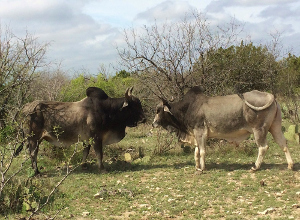 The Brahman, Bos Indicus, is believed to have originated over 4,000 years ago in India. The breed was introduced to Texas in the mid-1800’s. Although over 30 breeds belong in the Bos Indicus family, only four were used by the Texas breeders to develop the American Brahman cattle – the Guzerat, Gir (or Gyr), Nellore and Krishna Valley. In India, they are considered to be “sacred cattle”.
The Brahman, Bos Indicus, is believed to have originated over 4,000 years ago in India. The breed was introduced to Texas in the mid-1800’s. Although over 30 breeds belong in the Bos Indicus family, only four were used by the Texas breeders to develop the American Brahman cattle – the Guzerat, Gir (or Gyr), Nellore and Krishna Valley. In India, they are considered to be “sacred cattle”.
The most recognizable characteristic of the breed is the large hump over the top of the shoulders and neck. They also have horns which often curve upward, large drooping ears as well as a throatlatch and dewlap with large amounts of excess skin on the chest in front of the forelegs. The cattle also have more sweat glands than most other breeds and this allows them to tolerate the heat, up to 105° Fahrenheit, with little adverse effect. This makes them an ideal breed for the hot and dry conditions often found in Crockett County. The cattle can graze over long distances without water, another prized trait. The breed is resistant to ticks and other insects. Their glands produce hormones which have a distinct scent, and they have a tough hide with a subcutaneous muscle membrane that allows them to easily shake the insects off. They are basically immune to pinkeye and cancer eye, problems which plague many other cattle breeds.
According to the Texas State Historical Association, the breed had been being developed in Texas throughout the latter part of the 1800’s. The largest early importation attempted involved fifty-one Brahman cattle being shipped to the United States in 1906 under the direction of A.P. Borden. Borden, who had toured India with the goal of bringing home the best Brahman he could find, bought the cattle for the estate of Shanghai Pierce. This group of cattle was quarantined in the New York harbor and eighteen died of surra, a serious often fatal tropical disease transmitted by biting flies. Because of this outbreak, the Department of Agriculture blocked the importation of all cattle from India until 1946. As a result, almost all Brahman cattle imported to the U.S. during that time came via Brazil, driven by land through Mexico and into Texas.
Most cattlemen preferred to breed the Brahman with other breeds of cattle to introduce the Brahman desirable traits. The focus was on the Hereford and shorthorn breeds, but several other cattle breeds were eventually produced including the Santa Gerturdis cattle of King Ranch, Brangus, Beefmaster, Braford, Charbray, and Simbrah.
Brahman bulls weigh an average of 1,600 to 2,200 pounds, and cows usually weigh between 1,000 to 1,400. Cows are considered good mothers and even under tough Texas weather conditions continue to produce good milk flow. Brahman cattle live longer than many other breeds, sometimes producing calves at ages of 15 years or even older! They have a good reputation for producing high quality meat with little outside fat.
In 1964, Texas governor John Connolly proclaimed a Brahman bull, Bobo, the “Texan Ambassador of Goodwill”, and he was ridden by Jerry D. Cotton all the way from Texas to the World’s Fair in New York City, a journey of over 2,000 miles!
For more information about the area, visit our Local and Area Attractions pages!
Blue Grosbeak
A member of the Cardinal family, the Blue Grosbeak can be found throughout most of the southern United States and northern Mexico, and have even been spotted as far north as New Jersey. The name derives from the French word “gros-bec” which means “big beak”. The male of this beautiful species is characterized by vibrant blue feathers, the large triangular silver beak and bright splashes of chestnut wingbars. The females are mostly a rich cinnamon brown. At approximately six inches long, the Blue Grosbeak is considered a medium-sized bird.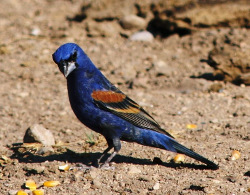
Blue Grosbeaks tend to feed on insects like grasshoppers and cicadas, but will also eat spiders, snails, seeds, fruit and other grains. They forage on or near the ground or will occasionally snatch an insect from the air.
Usually found nesting along forest edges, the Blue Grosbeak has been known to nest in salt cedar, commonly found along the Pecos River in western Crockett County, as well as orchards, brushy areas, willow or cottonwoods trees and even in freshwater marshes. When singing, they perch in the tops of tall trees and this is usually the easiest time to spot one.
The female builds the nest which can consist of stems, twigs, bark, cardboard, paper and other items like shed snakeskins and human hair. She will lay a clutch of about 4 eggs and once hatched about 11-12 days later, both the male and the female will care for the young. If it is early in the season and in the warmer climates, the female will re-nest and the male will care for the first fledglings. Each pair may rear two broods per season.
One problem faced by the Blue Grosbeak is parasitism of the Brown Headed and Bronzed Cowbirds which take over their nests. Sometimes, the Grosbeaks will build another nest on top of the Cowbird eggs in the original nest and eventually raise both sets of babies. It is believed the Blue Grosbeak population is in decline partly due to the parasitism and habitat degradation as human activity invades spaces where the Grosbeaks live.
For more information about the area, visit our Local and Area Attractions pages!
Plains Lubber Grasshopper
 Also known as the Homesteader, Plains Lubber Grasshoppers – Brachystola magna, can be found throughout the Great Plains from Canada all the way down to central Mexico. As the Latin name suggests, this insect is large. Adults average about 2 inches in length, but their wings are considered short for their size. Because of this, these grasshoppers are basically flightless and travel only by hopping or crawling along the ground. Researchers have observed these grasshoppers jumping up to 9 feet in a single hop!
Also known as the Homesteader, Plains Lubber Grasshoppers – Brachystola magna, can be found throughout the Great Plains from Canada all the way down to central Mexico. As the Latin name suggests, this insect is large. Adults average about 2 inches in length, but their wings are considered short for their size. Because of this, these grasshoppers are basically flightless and travel only by hopping or crawling along the ground. Researchers have observed these grasshoppers jumping up to 9 feet in a single hop!
Usually observed in the grassy areas and prairies, the Plains Lubber can often be seen in the tall grasses beside roadways. They can be found in desert grasslands, sandhills or any other place with abundant sunflowers. They also like to eat other plants, including ragweed, coneflowers, Indian paintbrushes, lettuce and many more. Though not usually found in large enough numbers to be a pest, outbreaks occur where the density of the population can be damaging especially for cotton. Favoring plants that farmers think of as weeds actually means that Plains Lubbers can be beneficial to crops when found in normal amounts. These grasshoppers don’t eat only plants, however. They have been known to eat other insects as well as carrion (dead animals)!
The Plains Lubber Grasshopper is a very colorful species, with colors ranging from gray, green, tan, ivory, yellow, red and even pink! Their color will become duller as they age. The bodies are striped and banded and often have knobs and wrinkles in their exoskeletons. Males have noticeably larger hind legs than the females.
Although more research is necessary to know for certain, it appears that eggs of this species must incubate for two years and require overwintering before they will hatch. However, some believe the eggs will hatch in only one season in the southern ranges. It is also thought the eggs could survive several years before hatching in dry, unpredictable climates. The hatched nymphs develop through five stages, or instars, and this usually lasts about 45 days.
These grasshoppers were especially useful in the study of genetics because they have large chromosomes. This feature made them easily observed in the early days of cell biology.
Look for these interesting insects as you drive the highways in Crockett County during the summer. These large grasshoppers are hard to miss!
For more information about the area, visit our Local and Area Attractions pages!
Angora Goats
Have you ever wondered what kind of fiber is used to make Santa’s beards and doll hair? Many times, it’s mohair. Prized for its clarity and luster, mohair is one of Crockett County’s ranching products. Not to be confused with Angora fiber, which is produced by rabbits, mohair is the fleece of Angora goats. Angoras produce two fleeces per year. Soft and lightweight, the mohair is highly sought after by weavers for all kinds of products, such as fine yarns, carpets, upholstery and clothing.
The Angora breed originated near Ankara, Turkey, from which the name is derived. Some scholars believe Angoras have been cultivated as far back as the 15th century B.C. because they are referenced in Sumerian cuneiform tablets as well as the Bible. The first documented Angora goats were sent to the United States as a gift from the Sultan Abdülmecid I of Turkey in 1849. The grateful Sultan sent nine adult goats to Dr. James P. Davis to show his appreciation for services and advice on raising cotton. More Angoras were later imported, but their numbers dropped significantly during the Civil War. Eventually, Texas became one of the primary mohair producers in the world due to the abundance of grasses and shrubs available for grazing.
Until recently, white Angoras have been preferred. But there is a small and growing market for colored Angoras. The Colored Angora Goat Breeders Association was set up in 1998 to promote breeding of these animals. These specialized Angoras can produce black (deep black to greys and silver), red (the color fades as the goat ages) and brownish fiber. Crockett County’s Angoras are still primarily white. An adult Angora will produce as much as ten to twelve pounds of mohair per year. The mohair fiber garments can be packed in less space than wool and resist wrinkling. Essentially non-flammable, the mohair fiber has a tensile strength that rivals steel of the same diameter.
Considered by some to be a high-maintenance animal, the Angora goat has been very successful in Crockett County. Besides that, baby goats like those seen in the photograph are just so CUTE!
For more information about the area, visit our Local and Area Attractions pages!
Hereford Cattle
Although no one is exactly sure where the Hereford breed of cattle actually began, it is generally accepted that it descended from the small red cattle of Roman Briton and a large Welsh breed once found along the border of England and Wales. Herefords are considered to have their origin in the county Herefordshire in England and are the first cattle from England to be recognized as a true breed.
Careful breeding practices over the past few hundred years have helped Herefords go through many changes. One of the earliest documented Herefords was bred in 1742 by Benjamin Tomkins. He and others continued to work toward breeding cattle with a natural aptitude in efficiency in feeding, ability to find grazing, hardiness, early maturity and high calf yield. The breed continued to be refined and grew in popularity. Eventually they were exported throughout the world. Early Herefords were much larger than today’s. In fact, in the early part of the 1800’s it was not uncommon to see a Hereford weigh 3000 pounds or more. Gradually, as the breed was refined they became smaller with higher quality meat as well as efficiency in reproduction.
In 1817, the politician Henry Clay imported the first three Herefords to the United States. Although they did not have much popularity at that time, the breed was brought back to public notice around 1840 when William Sotham and Erastus Corning began actively breeding and marketing them in the northeast part of the nation. The American Hereford Association was founded in 1881 and still works to promote and keep records for the breed.
Introduced to Texas after the Civil War, many cattlemen began to see the advantages of the Hereford breed, including Captain William S. Ikard who is believed to have brought the first Hereford cattle to Texas in the 1870’s. At first susceptible to tick fever, ranchers worked to breed cattle that had immunity. The price of bulls at this time could be as much as $300-$600, but even with losses to the fever the Herefords were still profitable. One of the more famous owners, Charles Goodnight, bought twenty head for his famous JA ranch in the Panhandle in 1883. The cattle quickly proved their hardiness and ability to thrive, so the next year Goodnight brought forty more directly from Herefordshire. Rapidly other Texas ranchers began to stock the breed and this was one of the major reasons for the decline of the Longhorn in Texas.
Although the red can vary from a deep cherry color to a lighter orange, all Herefords have red bodies with white faces. The white usually extends down the chest to the belly and along the top of the neck to the withers (top of the back just behind the shoulders). Although not as muscular as other breeds, the Hereford is blocky and smooth down the rump, loin, thighs and shoulders. One of the most highly adaptable breeds, Herefords can be found in Canada, the United States, Brazil, South Africa, Russia, New Zealand and Israel as well as many other countries. They do especially well on range where they are required to fend for themselves. Prized for tasty beef production, excellent maternal qualities, longevity and hardiness, Herefords have continued to be an economic success.
As you pass through Crockett County keep your eyes open and you may see several Herefords grazing in the pastures.
For more information about the area, visit our Local and Area Attractions pages!
Antheraea Polyphemus
This beautiful and colorful moth is a member of the family Saturniidae, also known as giant silk moths. Almost always some shade of tan, this moth is distinguished by large, purplish eyespots on its hind wings. In fact, the name Antheraea polyphemus comes from the Greek myth of the Cyclops Polyphemus. The eyespots are a defense mechanism used to try to startle predators away. With a wingspan that averages about 6 inches in width, these large moths are actually quite harmless. Found throughout the North American continent, these are the most widely distributed of the large silk moths.
In the adult form, the moths only live a few days. However, the moth form is only the last phase of a lifecycle that takes several forms. Beginning as a tiny egg attached to a leaf, branch or similar object, the small, yellow larvae hatch after about 10 days. For the next 5-6 weeks, the now green larvae, or caterpillars, eat and grow until reaching about 3 inches in length, consuming up to 86,000 times its own body weight! If feeling threatened during this phase, the catepillar will raise the front portion of its body, looking like a small green sphinx. Sometimes it will regurgitate some foul green liquid that repels ants and other insects. Along the way, the larvae molt five times, with the fifth molt putting them in the pupa stage. At this point they are bright green with silver spots on their sides. Finally they spin cocoons of brown silk, usually hidden in the leaves of a host plant or in scattered leaf rubbish in the brush. They will remain in this cocoon stage for at least two weeks and may even remain so over the winter.
When the adult moth finally emerges from the cocoon, it will live only a few days – just long enough to mate and lay the next generation of eggs. Usually emerging in the afternoon, the moths use the remaining daylight in expansion and drying of the wings. Females immediately begin emitting pheromones to attract males, sometimes up to a mile away. Male moths have thick bushy antenae which are used to detect the attractive chemicals. Usually mating a few hours before sunrise, the couple will remain paired all day until finally separating at dusk. The male will then soon die and the females will begin laying their eggs, continuing through the next few evenings before dying. In the adult phase, the moth have vestigial mouthparts, which is a fancy way to say they are not fully formed, rendering them unable to eat.
Although sometimes considered to be a pest in the California plum orchards, the moths pose no other real threat. Popular among hobbyists, the moths can be hand-raised though these efforts are not always successful. Some have even devised tether systems for the females and use them to attract multiple males when they are drawn by the powerful pheromones.
These interesting creatures are just a few of the varied wildlife found in Crockett County.
For more information about the area, visit our Local and Area Attractions pages!
Texas Spiny Lizard – Sceloporus olivaceus
Crockett County residents and travelers are often treated to the sight of a Texas Spiny Lizard, which can be found throughout the southern United States and northern Mexico. This long slender lizard is a member of the same species as the Horned Toad. Adults average 7.5 to11 inches in length, with 4 to 5 inches being the tail. They are usually grey in color with black, white, or red-brown blotching down the back. Males have blue patches of color on either side of their belly. The pattern of colors can vary greatly by locality and allows for camouflage against the bark of trees. Their scales have a distinct spiny texture and their toes are long with sharp claws that help them climb.
These lizards are primarily found where there are lots of trees and low scrub brush, but they can also be spotted on brick walls, bridges, telephone poles and sunning on sidewalks. Not aggressive and easily startled, the lizard will sprint away to climb a tree or be heard running noisily through the leaf litter underneath. The males lizards do have an unusual response when feeling threatened by another male. They will begin a push-up contest! They continue to do push-ups until one of them finally gives up and runs away.
The Texas Spiny Lizard is mature at about one year, breeding in the spring and summer months. Females can lay as many as four sets of eggs each year. They dig into the ground and lay clutches of about 14 eggs in the soil, which will hatch in about 50 to 60 days.
Because of their ability to breed so quickly, this lizard is not considered to be endangered and can be legally collected with a hunting license. Many people consider them to be good pets. They do need specialized ultraviolet (UVB and UVA) lighting and owners should be careful not to overfeed. They are voracious eaters and will consume all available prey, which can lead to digestion issues and even deformities. The Texas Spiny Lizard usually eats bugs, like crickets, ants and beetles, but they will occasionally eat small lizards and other vertebrates.
Many types of lizards visit our Crockett County Interpretive Trail!
For more information about the area, visit our Local and Area Attractions pages!
One of the most common species of tarantula living in the United States is the Texas Brown. Some individuals can have a leg span of 4-inches or more! The intensity of the shade of dark brown bodies will vary from spider to spider and is more distinct after a moult.
Enjoying a diet of mostly cockroaches, crickets and the occasional small mouse, the spider will lie in wait in the burrow and catch unsuspecting prey as it passes the entrance. Once caught, the tarantula will sink its fangs into the creature and suck out the insides like you might enjoy a large soda. Usually four to six crickets every few weeks will be enough to keep the tarantula healthy.
No one knows just how long a female tarantula can live but some have been known to live 30 years. The males rarely live more than a few years. The female can lay up to 1,000 eggs, which are secured in a web inside the spider’s burrow so that she can guard them. Once hatched, the spiderlings may remain in the burrow for a week or more before setting out to make their own homes. Preferring to live in soil where they can dig their burrow, the tarantula can climb and be found in unexpected dark and damp places.
Normally not aggressive, these spiders are often kept as pets. However, when feeling threatened, the tarantula will use one of several forms of defense. They may run for cover or shed tiny hair from their abdomen causing irritation in the predator’s eyes, nostrils, or mouth. Another way of trying to deter an unwanted threat is to lean back on its rear legs, throwing its front legs up and lifting its body in a fighting position. If no other option is available, the tarantula can bite with its fangs. It has a weak venom that will not cause serious harm to humans.
For more information about the area, visit our Local and Area Attractions pages!
Autumn, or Fall, is the season between summer and winter. It’s a time of slowing down for plants and animals alike. The nights become longer and the days grow shorter, and temperatures drop. Deciduous trees take these changes as a time to prepare for winter.
Gradually, trees move the green chlorophyll used in photosynthesis from the leaves to the roots for storage of energy to be used in the months to come. The remaining cells in the leaves give the various colors common in fall, ranging from brown to gold, yellow, red, and orange. Soon, with no energy-giving chlorophyll, the leaves die and fall to the ground. The beautiful changes are viewed by thousands of tourists who travel hundreds of miles to enjoy the short-lived explosion of color. Recently the term of “Leaf Peeper” has gained popularity to describe the tourists that bring both money and congestion to the roads passing through the communities where the scenery is vivid.
Associated with the harvest season, many cultures celebrate fall with festivals. The United States and Canada celebrate Thanksgiving during this time. Many tribes of Native Americans hold festivals filled with ripe fruits, grains and vegetables. The Jewish nation has a Feast of Tabernacles where they live in small shelters and tents outside their homes for a week, also called Sukkot. People in China celebrate a Moon Festival. These are just a few of the ways that people celebrate, but the common theme of them all is to express joy in the fruits of the earth and a little bit of melancholy with the approach of the cold, dark season of winter.
Also connected with fall are holidays surrounding the Halloween season. Influenced by Samhain, an ancient Celtic festival, the celebrations have spread throughout the world. All Hallows’ Eve, the Dia de Muertos (Day of the Dead), and All Souls’ Day are celebrated in Mexico as well as Central and South America. Participants honor their dead by building private altars, using sugar skull, marigolds and the favorite foods and drinks of their departed, and visiting graves with gifts. Europeans also hold celebrations where they visit loved ones graves carrying candles and food and sometimes milk to pour onto the ground. In the Philippines, families actually treat this time as a family reunion and celebrate all night in the cemeteries or near tombs.
For more information about the area, visit our Local and Area Attractions pages!
Raccoons are small, furry mammals found throughout Canada and the Central United States. Gray in color, and usually between 10 and 30 pounds, they are recognizable by the strip of black fur across their eyes and snout as well as the black rings around their long, bushy tails. Not too picky about where they live, raccoons may be found in hollow trees, rocky crevices and outcroppings, or even in barns, chimneys and attics. Raccoons will feed on almost anything available from insects, fruit, acorns, mice, snakes, birds or garbage. They also like corn and other cultivated crops. Dog and cat food also make a tasty meal. Because of their ability to eat so many different kinds of food, raccoons can be found even in urban areas, though they prefer streams, lakes and wilderness.
Versatile creatures, raccoons have dexterous hands with long fingers which they use to climb trees, open containers and garbage cans. These hands become more sensitive underwater because the usually hard layered skin on their palms becomes pliable when wet, increasing the ability to feel objects. Raccoons find a lot of their food while feeling around underwater and many believe that they “wash” the food. But research has shown that in the wild, there is no natural tendency to “wash” or douse the food.
Raccoons are sometimes regarded as pests because they damage attics and gardens, eat fruit from trees, and dig up yards and gardens looking for insects and seeds. Sometimes, they will even enter homes looking for food. They are often carriers of diseases like rabies and distemper as well as parasites like ticks, fleas and lice.
Almost exclusively nocturnal, raccoons have acute hearing and night vision. They are also strong swimmers. During the day, they sleep in their nests, and in cold weather they may sleep for extended periods of time, but they do not hibernate. Curious and intelligent, studies have shown that raccoons can remember solutions to tasks for as long as three years.
Adult raccoons have few natural enemies, though young raccoons are prey to coyotes, bobcats and other wild animals. Raccoon may live 10-15 years in the wild, but the average life expectancy is less than 3 years, due to hunting, vehicular injuries and disease. Despite all these dangers, raccoon populations continue to thrive and are not in decline in Texas.
Christopher Columbus described raccoons in his journals during his first visit to the new world. The name originated as the Native American word “arakun” meaning “he scratches with his hands”. Early colonists soon shortened the name by dropping the “a” and thus the name raccoon was used.
There are six species other than the common raccoon found in the U.S. Most of these are found in tropical islands and Japan. The common raccoon has also been introduced into Germany and other parts of Europe due to release or escapes from zoos and fur farms.
Raccoons may be seen at night near roadways, fields and other areas throughout Crockett County. They are not domesticated and should always be treated as wild animals. They are cute to watch, but can be dangerous if feeling threatened. Take photos if you like, but keep your distance.
For more information about the area, visit our Local and Area Attractions pages!
The Pecos River Canyon marks the western boundary of Crockett County, which is the 8th largest county in the state of Texas. It also forms the dividing line between the Edwards Plateau and the Trans Pecos regions. Although Crockett County is the far western boundary of the Edwards Plateau which is called the Hill Country, visitors can see many of the changes marking the transition into the Trans Pecos region that stretches as far west as El Paso, northward to the Texas/New Mexico border and southward to the Rio Grande river. From slow rolling hills and farming areas in the northeastern part of the county to the rugged Pecos River Canyon, travelers can view a wide variety of rock formations and strata, ecosystems as well as many kinds of plants and wildlife.
The northeastern portions of Crockett County are considered to be at the southern tip of the Great Plains, and this can be viewed in the slow rolling hills with cattle, sheep and goats grazing the grasses. As you move westward, you will begin to see deeper canyons with more exposed rock and strata. These areas include white-tailed deer, javelina, jackrabbits, roadrunners and many other types of wildlife. You will also begin to notice as you go farther west that the stock includes more goats than cattle. By the time you reach the far western boundaries of the county the stock is predominately goats. Historically, Crockett County has been a major supplier of both wool and mohair.
The southern part of Crockett County is marked with steeper and deeper canyons, revealing incredible strata, much of it from the lower cretaceous era. Sparse rainfall, rock outcroppings and rugged terrain make this area difficult to ranch. Much of the stock work in this area is still done by horseback because of the abrupt changes in topography.
Throughout the entire county, the traveler will notice that ranches are large because it takes more land to support each animal. Recently, some of the ranches have turned to eco-tourism as a way to supplement income, and there are several places where visitors can stay to view the wildlife, birds, and the geography of the area. Hunting has also grown into a major part of the local economy with people coming hundreds of miles to take advantage of the abundant deer and other animals. Many ranches now rely on the hunting industry as a large part of their operations, managing the deer in much the same way as other ranchers manage cattle, sheep and goats.
Oil and natural gas production are a major part of the local economy and bring large fluctuations in the local population as drilling increases or decreases. With expansion of ways to retrieve the oil and gas from the underground formations, this industry is playing a much larger role in the local economy. Over 8,000,000 barrels of oil were produced in Crockett County during 2013, helping America become more energy independent. New technologies continue to increase the natural gas production as well.
There are so many different kinds of things to see and do in Crockett County. We hope you will visit us soon. It’s a great place to hang your hat!
For more information about the area, visit our Local and Area Attractions pages!
Texas is home to three different species of turkey: the Merriam turkey, the Eastern turkey and the Rio Grande turkey. Most turkeys in Crockett County are Rio Grande turkeys, which are distinguishable by the buff colored tips on their tail-feathers and long legs. Adult male turkeys, called gobblers, may weigh as much as 20 pounds, and adult females, called hens, are about 8-10 pounds. Besides being larger, gobblers are darker in color and have a beard. Their head is featherless and white on top, with blue cheeks, supported by a red neck. The snood (the fleshy protrusion between the turkey’s eyes) is also much larger and hangs down beside the beak. Hens’ heads are covered with small buff colored feathers and are drab blue-grey. Their snoods are barely noticeable.
Turkeys are native to the New World and Spanish explorers noted that Aztecs and other Native Americans already had domesticated turkeys in 1519. The breed was introduced to Europe by Vasco de Gama. Hunted almost to extinction in Texas by the late 1800’s, limits on hunting and successful restocking programs have re-introduced turkeys into most of their remaining natural habitats. Turkeys may range up to 10 miles when moving from wintering areas to nesting places.
Rio Grande turkeys require water, knee-high grasses and weeds for successful nesting and can be found in large numbers near rivers and other water courses. Hens must have nearby sources to transport water to the nests in order to keep the eggs cool and moist during the heat of the day. Incubation takes 28 days, and the young hatchlings, called poults, are able to fly and roost in trees within two weeks. Turkeys live an average of 2-3 years, though individual turkeys have been known to live as long as 10 years. Hens lay about 9-11 eggs at a time, but only about 2 or 3 of the poults survive to adulthood. Predators include coyotes, foxes, raccoons, skunks, wildcats, snakes, owls and hawks, just to name a few.
Primarily herbivorous, turkeys also eat insects, snails, and other invertebrates. Major food sources come from grasses, nuts, seeds, acorns, flowers and other available forage. Many ranchers manage their turkey population and have to be especially careful when using supplemental feeds. Corn or other grain sorghum may be infected with aflatoxin which is produced by molds in the feed. This toxin can be detrimental and sometimes poisonous to the turkeys as well as other livestock.
Turkeys can often be seen in Ozona in the early mornings and right before sundown as they head to roost. Fall is an especially good time to see turkeys in town as they like to forage on the pecans that fall from the trees throughout the downtown and residences.
For more information about the area, visit our Local and Area Attractions pages!
Gayfeather - Liatris punctata
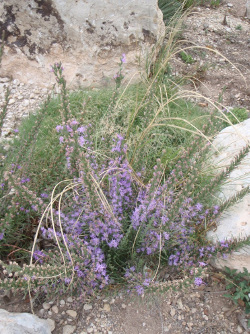 A member of the Aster or sunflower family, the gayfeather is known by many other names: Dotted Gayfeather, Dotted Blazingstar, Nebraska Blazing Star, Button Snakeroot, and Starwort, just to name a few. The word punctate actually means “dotted”, and refers to the speckles that appear on the leaves.
A member of the Aster or sunflower family, the gayfeather is known by many other names: Dotted Gayfeather, Dotted Blazingstar, Nebraska Blazing Star, Button Snakeroot, and Starwort, just to name a few. The word punctate actually means “dotted”, and refers to the speckles that appear on the leaves.
Very versatile, the plant has been used for centuries. Both boiled and baked, Native American tribes used it for many different medicinal purposes. The Blackfeet used boiled roots to reduce swelling. The Omaha tribe used powdered roots to make a poultice for external inflammation and made a tea from the plant to treat stomachaches and other abdominal troubles. Pawnees boiled the leaves and roots together to help their children when they suffered from diarrhea. The root was even used as a treatment for snakebite! Today the plant is gaining in popularity as an ornamental because it can be used in fresh floral arrangements and winter bouquets as well as dried arrangements.
The plant grows to be only a few feet tall, but its thick taproot can reach as deep as 15 feet. Laterally, it will spread to about three to four feet. Because of the deep root, the plant is very drought-tolerant. It is also fire-tolerant and will re-sprout to continue spreading its seed, usually by the wind. Some samples of the gayfeather have been known to live over 35 years!
The plant is feed and forage for many animals and insects, including white-tailed deer, elk, livestock, butterflies and bees. Rodents will eat the flower buds, seedlings, new leaves and roots of this species.
You can view the gayfeather shown in the photo in the Crockett County Interpretive Trail located across the parking area from the Ozona Chamber of Commerce & Visitor Center.
For more information about the area, visit our Local and Area Attractions pages!
Dorper Sheep
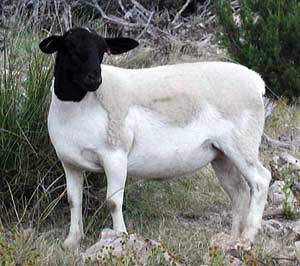 In the late 1940’s and 1950’s the South African Department of Agriculture set out to produce a breed of sheep that would give high quality meat and thrive in arid and semi-arid environments. By crossing Dorset Horn rams with Blackhead Persian ewes, they were able to breed an easy care, thick-skinned sheep that was extremely adaptable and flourished even in irregular and low rainfall areas. Using the first syllable from Dorset and Persian, the name Dorper was chosen for the new breed. The Dorper skin is one of the most highly prized sheepskins in the world and is marketed under the name of Cape Glovers. Dorpers do not need to be sheared because they shed their thin wool coats in the spring allowing them to withstand extreme heat in the summer.
In the late 1940’s and 1950’s the South African Department of Agriculture set out to produce a breed of sheep that would give high quality meat and thrive in arid and semi-arid environments. By crossing Dorset Horn rams with Blackhead Persian ewes, they were able to breed an easy care, thick-skinned sheep that was extremely adaptable and flourished even in irregular and low rainfall areas. Using the first syllable from Dorset and Persian, the name Dorper was chosen for the new breed. The Dorper skin is one of the most highly prized sheepskins in the world and is marketed under the name of Cape Glovers. Dorpers do not need to be sheared because they shed their thin wool coats in the spring allowing them to withstand extreme heat in the summer.
The American Dorper Sheep Breeders’ Society was formed in December of 1995, and the Dorper breed was brought to the United States shortly thereafter. The popularity of the breed continues to spread and is one of the fastest growing breeds of sheep in the nation. Currently, ranchers in Crockett County are turning to this sheep to increase efficiency and production even in arid conditions.
For more information about the area, visit our Local and Area Attractions pages!
Horned Toad
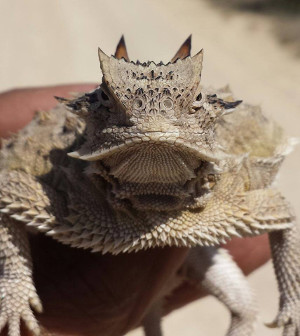 Also known as a short-horned lizard or horny toad, this reptile has a short, blunt head and a flattened body covered with sharp points. Found mostly in arid, desert areas, there are over a dozen different species found throughout North and Central America. Their coloring can range from a caliche-colored tan to a red-brown, depending on their environment. The shape of their bodies combined with the numerous spines covering their bodies make them easily camouflaged. Dining primarily on ants, they have been known to also eat grasshoppers, beetles and spiders. Often prey of other creatures, including hawks, snakes, coyotes, and more, some species have the ability to squirt blood from the ducts in the corners of their eyes, shooting streams up to distances of three feet. Besides being impressive, this blood contains a chemical that is noxious to dogs, wolves and coyotes. The various species have been in decline throughout their natural ranges, due to efforts to eradicate ants – their primary food source. Many have been gathered as pets, also contributing to the reduction of the number of horned toads found in the wild.
Also known as a short-horned lizard or horny toad, this reptile has a short, blunt head and a flattened body covered with sharp points. Found mostly in arid, desert areas, there are over a dozen different species found throughout North and Central America. Their coloring can range from a caliche-colored tan to a red-brown, depending on their environment. The shape of their bodies combined with the numerous spines covering their bodies make them easily camouflaged. Dining primarily on ants, they have been known to also eat grasshoppers, beetles and spiders. Often prey of other creatures, including hawks, snakes, coyotes, and more, some species have the ability to squirt blood from the ducts in the corners of their eyes, shooting streams up to distances of three feet. Besides being impressive, this blood contains a chemical that is noxious to dogs, wolves and coyotes. The various species have been in decline throughout their natural ranges, due to efforts to eradicate ants – their primary food source. Many have been gathered as pets, also contributing to the reduction of the number of horned toads found in the wild.
For more information about the area, visit our Local and Area Attractions pages!
Thinking about visiting the area?
Learn more about Ozona and Crockett County
when you visit our Tourist Information page.

